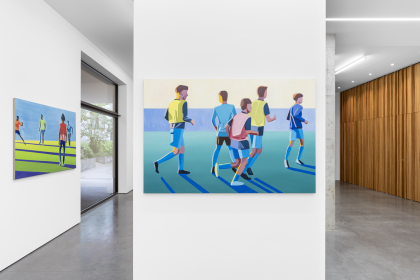
The other team
“I am deeply saddened and outraged by the explosion at the hospital in Gaza yesterday. Based on what I’ve seen, it appears as though it was done by the other team, not you”.
(Biden to Netanyahu in reference to the attack on al-Ahli hospital on the 17th October 2023 that killed hundreds of people.)
A matter of teams. ‘Us' and 'them'. Red t-shirt, blue t-shirt. The entire population of Gaza is reduced with this phrase to a team, more precisely, the enemy team. What is the enemy team? It is an agglomeration of anonymous individuals that I understand as being opposed to me. They can, therefore, be eliminated. Any negative action can be carried out against them that I would qualify as a crime if it were committed against those of my team. Because they are the other team, and my empathy only covers the colour of a t-shirt.
We divide the world into categories that we associate with symbols. Words like 'left', 'centre' or ‘right’; physical elements like a flag, serve to associate heterogeneous groups of people with concrete ideas, determining in a few seconds our position towards the other. To what extent do we consciously belong to our teams? If those in which I include myself are made up of complex and nuanced people, the other is almost always an abstract mass. It is easier to develop this kind of manichean and puerile contempt against an unknown enemy. Are there not members of the opposing team with whom I sympathize? Do I sympathize with all the members of my team?
Let's look at the following experiment conducted with a couple: one person sees their partner suffer; as a result, the part of their brain corresponding to pain is involuntarily activated. The same test is performed with a football fan: the supporter of one team sees a member of the opposing team suffer; this time it is the reward part that is activated in their brain (*1). The colour of the t-shirt has defined the affinity group, automatically turning a stranger into the enemy. This apparently superficial example can in my opinion be extrapolated to many other aspects of society: isn't there a similarity between the mechanism that leads me to celebrate the defeat of the opposing team and the one that leads me to invade the neighbouring country?
I also remember a story about the Spanish Civil War in which it was recounted how fellow drinkers debated politics in cafés (*2). In a matter of a few months, this diverse group of friendships and ideas had split into the two sides of war. The plurality of reality gave way to a forced segmentation into excluding groups, where the multiple aspects of each individual's personality were disregarded in favour of a single idea: which is your party. Certain factors (in discussions, in behaviour, in aesthetics) had to be the symptoms prior to the outbreak of events. Perhaps, if they had been discovered in time, things would have turned out differently.
It was with these thoughts in mind that I stumbled upon a football training session one afternoon. A group of white men, in uniform, running and jumping in the same direction, following the coach's instructions. On the next court, the one for the non-federated, a group of immigrants were playing without uniforms or referees. In this society that tends to teams, we know who has set the rules. Are these divisions really inevitable, or could things be done differently?
I stare at a player: he seems to be dancing between the lines that delimit the field.
*1 Gilman, S. and de Lestrade, T.V. (Directors). (2015). The Altruism Revolution (Film). First Run Features. M. 40
*2 Cercas, J. (2002). Soldados de Salamina. Tusquets Editores. P. 87









